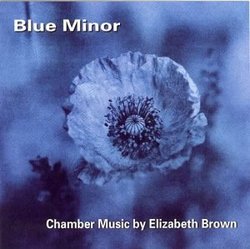| All Artists: Elizabeth Brown, Margaret A. Kampmeier, Susan Walters Title: Blue Minor: Chamber Music by Elizabeth Brown Members Wishing: 0 Total Copies: 0 Label: Albany Records Original Release Date: 1/1/2000 Re-Release Date: 12/30/2003 Genres: Special Interest, Classical Styles: Holiday & Wedding, Opera & Classical Vocal, Chamber Music, Historical Periods, Classical (c.1770-1830) Number of Discs: 1 SwapaCD Credits: 1 UPC: 034061062721 |
Search - Elizabeth Brown, Margaret A. Kampmeier, Susan Walters :: Blue Minor: Chamber Music by Elizabeth Brown
 | Elizabeth Brown, Margaret A. Kampmeier, Susan Walters Blue Minor: Chamber Music by Elizabeth Brown Genres: Special Interest, Classical
|
Larger Image |
CD DetailsSimilar CDs |
CD ReviewsWicked, Woozy and Wondrous J Scott Morrison | Middlebury VT, USA | 01/16/2004 (5 out of 5 stars) "One of the joys of listening to music by little-known composers is that sometimes you really luck onto something wonderful. And that is what has happened for me with this CD of some chamber music by Elizabeth Brown; I'd known of her as a flutist, but not as a composer. Music must drip from her finger tips; it all seems inspired in the way that Mozart's music is inspired, as if it simply flowed out of her. I have no idea how difficult it was for her to write these pieces, but they are so smoothly wrought that it sounds as if she simply served as the music's vessel. OK, I know that sounds very 19th-century, but it feels as if nothing had impeded its composition. Partly, I'm sure, that is because Ms Brown knows what she wants to do and has the technical means to do it. Fortunately, also, she has an ear for intriguing sounds, memorable melodies, and an ability to limn emotion musically. Everything on this disc is attractive, and it has an unmistakably personal sound that so many composers seem to lack. The music rarely rises above a mezzo-forte, and the commonest mood is a kind of gentle melancholy, a ruminative reflection, but there is also occasional drama, frequent wry good humor, abundant lyricism. There is a good bit of Asian influence--indeed in one piece, 'Acadia,' (so named because she wrote if while at Acadia National Park in Maine), she plays both flute and shakuhachi. Her music occasionally quotes, sometimes mercurially, sometimes obsessively, old familiar tunes (e.g. 'Au claire de la lune' in 'Liguria') that somehow fit right in to the overall sound-picture. One suspects that she has been influenced by the music of, say, Lou Harrison or Colin McPhee as well as good ol' Charlie Ives. Another element is microtonal bending of tones; I have rarely felt comfortable with microtonal techniques, but here it not only is accessible and enjoyable, it also adds piquancy and point. Sometimes, too, it is simply laugh-out-loud funny, hence the use of 'woozy' in my subject line. There is an occasional 'in-joke' aspect to her music; I suspect that's one reason she has been able to round up such a distinguished group of chamber musicians to make this recording. I can only imagine they had a wonderful time playing her music. The pieces are 'Blue Minor' (2001) for flute and string quartet, 'Liguria' (1999) for flute, clarinet, violin, cello and piano, 'Acadia' (1999) for solo flute and solo shakuhachi (both played by Ms Brown), 'Figures in a Landscape'(1995) for violin, viola, cello, bass and piano, and 'The Memory Palace' (1990) for flute, cello and piano. I won't attempt an analyis or even a detailed description of the music beyond what I've written above. 'Blue Minor,' in four movements ('In the deep bare garden; Alone; Be still; Listening to the evening') is the longest piece at about 15 minutes. 'Figures in a Landscape' is slightly shorter at 14 minutes; recorded in Ms Brown's Upper West Side apartment in New York, in 'Figures' there is an unscripted appearance by a distant siren wail from the street below; it not only doesn't interfere with one's pleasure, it somehow adds to it. A final word about Ms Brown's musical style. Most of the music is unabashedly tonal, although sometimes stretched to its limits and polytonal at times. The microtones, glissandi, intentionally out-of-tune double stops and the like are like carefully considered decorations, adding to the music's overall spiciness. There is also a dream-like quality to much of the music; partly that's the use of multilayering and partly the character of the material itself. Formally the pieces are probably best described as fantasias, but there are cyclic elements and some instances of free counterpoint that hew to Western templates. There are occasional sudden tempo and dynamic changes, sometimes like those in, say, Ive's 'Unanswered Question', arising out of the layering. And craftily done, too.The sound is clear and lifelike, subtly resonant and with breathing space around it. The performers, most of them New York jobbing musicians, include such musicians as violinists Curtis Macomber and Joanna Jenner, pianists Margaret Kampmeier and Susan Walters, clarinetist Jo-Ann Sternberg, violist Betty Hauck, cellists Greg Hesselink and Joshua Gordon, bassist Dennis James, as well as the composer playing flute. Hats off to all of them; this is exemplary playing. Recommended.TT=57:06Scott Morrison"
|

 Track Listings (8) - Disc #1
Track Listings (8) - Disc #1